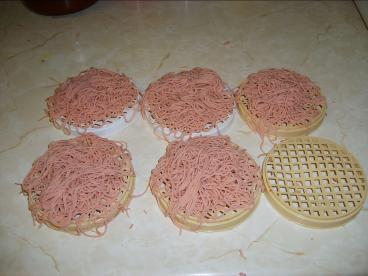
|
My food habits
Mostly I eat vegetarian food. This is because I feel sorry for animals in particular for those who are not treated humanely before they are killed. I occasionally eat fish. I also eat vegetarian food because I think it can help research and development of vegetarian food products with more nutrition and better flavour. So, I eat quite a lot of tofu, soya and other proprietary vegetarian products.
|
|
SriLankan breakfasts
Recently a colleague asked me to write about Srilankan breakfasts. Sri lankans enjoy a wide variety of breakfast dishes. Although some people have preference for western breakfast items such as cereals, bacon, sausages, eggs and toast many Srilankan families prefer the taste of traditional breakfast dishes, like rice left over from previous night (heel-bath), string hoppers (indi-appa), hoppers (appa), and milk rice (kiri-bath).
Rice has been the staple food of Srilankans for many centuries. Heel—bath is the remnants of rice cooked for the dinner and left overnight for the morning meal. In the olden days it was common practice (particularly in villages) to keep rice left over from dinner and eat with left over curry. When I was a kid my mother used to temper the left over rice in coconut oil with curry leaves and peppercorns . This was normally served with dhal and fish curries, which I relished.
String hoppers (indi-appa) is another dish which is very popular among Srilankans. These consist thin noodle like strings made from a dough of rice flour (normally mixed with steamed plain flour ) squeezed through a sieve on to small round (woven or plastic) trays (see the photos). These are then cooked in a steamer. String hoppers are usually eaten with curries (like dhal curry, potato curry ,fish curry) and coconut sambol.
|

|
About 30 cooked string hoppers on a plate |


|
Individual cooked string hoppers on a plate—the colour comes from red rice flour |
|
Uncooked string hoppers on plastic trays and an empty tray. |

|
This is a gadget traditionally used to squeeze the dough. One part of it has the sieve at the bottom and it is filled with the dough. The other part is used to press the dough through the sieve. |
|
My food habits |
|
|